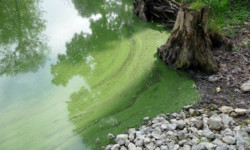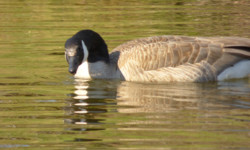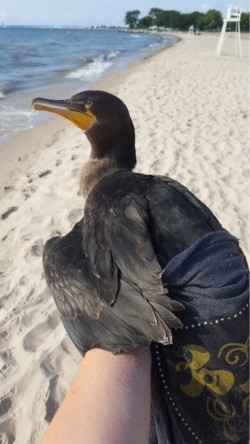Blue-Green Algae and Avian Botulism Pose Late Summer Health Threats
Aug 11, 2021
As we head into the dog days of summer, dogs and people are drawn to the cool waters of local lakes and ponds.
Swimming, boating, and other water recreation that we share with our pets is a prime source of outdoor entertainment to beat the heat. However, August and September can be dangerous periods to be in or around natural water bodies for people, pets, and wildlife.
Blue-Green Algae Can be Toxic to Pets and Humans
Blue-green algae is actually not algae at all. It’s a type of bacteria, called cyanobacteria, that photosynthesize like plants and algae. Bacteria colonize bodies of water and thrive when the water is warm and full of nutrients, creating a bloom that looks like paint spilled on the surface – sometimes leaving it looking like pea soup. Mown lawns, fertilizers, agricultural runoff, pet waste, goose droppings, and more all contribute to nutrient levels in ponds. Hot and dry conditions in late summer leave lakes and ponds warmer and shallower: perfect for blue-green algae to bloom in.



These colonies of bacteria can create toxins that seep into the water, but you can’t tell by looking. Determining if a colony is toxic requires careful testing. Killing the colonies doesn’t solve the problem because dead bacteria release even more toxins. These toxins are dangerous to animals and people. Dogs can become sick and die after wading in and then licking their fur. In humans, cyanobacteria poisoning can cause vomiting, weakness, lethargy, diarrhea, seizures, and more. If you see any signs of cyanobacteria blooms in your local recreational waters, stay out and contact your local health department.
Avian Botulism Deadly in Small Doses
Avian botulism is a disease caused by neurotoxins released by the bacteria Clostridium botulinum. This toxin is one of the most potent known to science and is deadly in very small doses. Once ingested, it leads to paralysis and usually death. There are seven strains of botulism with the “C” strain being most common in wild birds. Outbreaks of avian botulism occur regularly in the Great Lakes region and Midwest and botulism is a leading cause of disease-related bird deaths in the U.S. As with blue-green algae, outbreaks most often occur when water levels are low. This causes waterfowl to congregate at smaller and smaller water bodies. When a bird dies from botulism, flies lay eggs on the corpse. Maggots hatch and feed on the dead bird, ingesting the bacteria and toxins. When another bird eats those maggots, that bird then gets sick and dies and the process is repeated, sometimes resulting in the deaths of thousands of birds on the same shoreline. Initial symptoms of avian botulism in birds include weakness, inability to fly or walk, and most commonly, paralysis that affects the neck muscles first, preventing an affected bird from holding its head up.


While a rare occurrence, avian botulism can be transmitted to humans. Accidental ingestion of contaminated water or consumption of contaminated food can lead to illness and death. Pets, especially dogs, are at higher risk because of their tendency to roll in and even eat things like dead birds. If you see a dead duck, goose, or other bird along the shoreline, avoid the area and report the find to your local health department.
FUN FACT: Botox is derived from the toxin produced by C. botulinum and gets its name from botulism and toxin. The paralytic toxin is used to treat headaches and neck spasms, among other therapeutic uses, as well as for reducing facial wrinkles.
Stay Safe in the Hot Summer Months with Awareness of Water-Borne Hazards
Awareness is the best way to stay safe. Inspect your local waterways before coming into contact or allowing pets off-leash to swim. Concerns should be directed to your local health department so that water can be tested and warnings issued when appropriate.
Professional, Biology-based Help for Agricultural and Commercial Bird Conflicts
The Wild Goose Chase team has decades of experiencing in managing a wide variety of bird-related conflicts, with an array of safe, cost-effective and biology-based deterrents to keep your property safe and free of pest birds and the diseases they can spread to people, pets and agricultural crops and livestock.


 0
0
